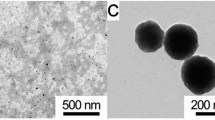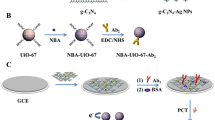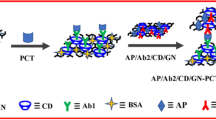Abstract
In this paper, a dual-signal amplified electrochemical immunosensor for quantitative detection of capsaicinoids in serum was reported, which could be used to study the pharmacological properties of capsaicinoids. To improve the sensitivity of the immunosensor, the glassy carbon electrode was modified with Prussian blue-gold nanocomposites (PB-AuNPs) and thionine (TH). PB-AuNPs provided better electrical conductivity. At the same time, TH enhanced the stability of electron transfer, leading to superior electrochemical performance. Meanwhile, an excellent anti-capsaicinoids antibody (Ab) was used to ensure the sensitivity and specificity of the electrochemical immunosensor. The prepared immunosensor was tested using cyclic voltammetry (CV) and differential pulse voltammetry (DPV). Under the optimal conditions, the proposed immunosensor displayed a wide linear range from 0.01 to 1000 ng/mL with a detection limit of 0.01 ng/mL and showed good recoveries (85.12–104.25%) and high stability. Additionally, the immunosensor was successfully applied to monitor capsaicinoids in real serum samples.







Similar content being viewed by others
References
Morozova K, Rodríguez-Buenfil I, López-Domínguez C, Ramírez-Sucre M, Ballabio D, Scampicchio M (2019) Capsaicinoids in chili habanero by flow injection with coulometric array detection. Electroanal 31(5):844–850
Laskaridou MA (1999) Determination of capsaicin and dihydrocapsaicin by micellar electrokinetic capillary chromatography and its application to various species of Capsicum. J Chromatogr A 838(1-2):293–302
Friedman JR, Richbart SD, Merritt JC, Brown KC, Denning KL, Tirona MT, Valentovic MA, Miles SL, Dasgupta P (2019) Capsaicinoids: multiple effects on angiogenesis, invasion and metastasis in human cancers. Biomed Pharmacother 118:109317
O'Neill J, Brock C, Olesen AE, Andresen T, Nilsson M, Dickenson AH (2012) Unravelling the mystery of capsaicin: a tool to understand and treat pain. Pharmacol Rev 64(4):939–971
Chung MK, Campbell JN (2016) Use of capsaicin to treat pain: mechanistic and therapeutic considerations. Pharmaceuticals 9(4):66
Frias B, Merighi A (2016) Capsaicin, nociception and pain. Molecules 21(6):797
Chapa-Oliver AM, Mejia-Teniente L (2016) Capsaicin: from plants to a cancer-suppressing agent. Molecules 21(8):931
Adamek P, Heles M, Palecek J (2019) Mechanical allodynia and enhanced responses to capsaicin are mediated by PI3K in a paclitaxel model of peripheral neuropathy. Neuropharmacology 146:163–174
Borbély É, Botz B, Bölcskei K, Kenyér T, Kereskai L, Kiss T, Szolcsányi J, Pintér E, Csepregi JZ, Mócsai A, Helyes Z (2015) Capsaicin-sensitive sensory nerves exert complex regulatory functions in the serum-transfer mouse model of autoimmune arthritis. Brain Behav Immun 45:50–59
Maksimova V, Gudeva LK, Gulaboski R, Nieber K (2016) Co-extracted bioactive compounds in capsicum fruit extracts prevent the cytotoxic effects of capsaicin on B104 neuroblastoma cells. Rev Bras Farmacogn 26(6):744–750
Zak A, Siwinska N, Slowikowska M, Borowicz H, Szpot P, Zawadzki M, Niedzwiedz A (2018) The detection of capsaicin and dihydrocapsaicin in horse serum following long-term local administration. BMC Vet Res 14(1):193
You YW, Uboh CE, Soma LR, Guan FY, Taylor D, Li XQ, Liu Y, Chen JW (2013) Validated UHPLC-MS-MS method for rapid analysis of capsaicin and dihydrocapsaicin in equine plasma for doping control. J Anal Toxicol 37(2):122–132
Yang QQ, Zhu JG, Ma F, Li PW, Zhang LX, Zhang W, Ding XX, Zhang Q (2016) Quantitative determination of major capsaicinoids in serum by ELISA and time-resolved fluorescent immunoassay based on monoclonal antibodies. Biosens Bioelectron 81:229–235
Ma F, Yang QQ, Matthäus B, Li PW, Zhang Q, Zhang LX (2016) Simultaneous determination of capsaicin and dihydrocapsaicin for vegetable oil adulteration by immunoaffinity chromatography cleanup coupled with LC–MS/MS. J Chromatogr B 1021:137–144
Pena-Alvarež A, Ramírez-Maya E, Alvarado-Suárez LA (2009) Analysis of capsaicin and dihydrocapsaicin in peppers and pepper sauces by solid phase microextraction–gas chromatography–mass spectrometry. J Chromatogr A 1216(14):2843–2847
Reilly CA, Crouch DJ, Yost GS, Fatah AA (2001) Determination of capsaicin, dihydrocapsaicin, and nonivamide in self-defense weapons by liquid chromatography–mass spectrometry and liquid chromatography–tandem mass spectrometry. J Chromatogr A 912(2):259–267
Reilly CA, Crouch DJ, Yost GS, Fatah AA (2002) Determination of capsaicin, nonivamide, and dihydrocapsaicin in blood and tissue by liquid chromatography-tandem mass spectrometry. J Anal Toxicol 26(6):313–319
Kehie M, Kumaria S, Tandon P (2013) In vitro plantlet regeneration from cotyledon segments of capsicum chinense Jacq. cv. Naga King Chili, and determination of capsaicin content in fruits of in vitro propagated plants by high performance liquid chromatography. Sci Hortic-Amsterdam 164:1–8
Stipcovich T, Barbero GF, Ferreiro-González M, Palma M, Barroso CG (2018) Fast analysis of capsaicinoids in Naga Jolokia extracts (Capsicum chinense) by high-performance liquid chromatography using fused core columns. Food Chem 239:217–224
Zhai C, Sun X, Zhao WP, Gong ZL, Wang XY (2013) Acetylcholinesterase biosensor based on chitosan/prussian blue/multiwall carbon nanotubes/hollow gold nanospheres nanocomposite film by one-step electrodeposition. Biosens Bioelectron 42:124–130
Ziyatdinova G, Ziganshina E, Shamsevalieva A, Budnikov H (2020) Voltammetric determination of capsaicin using CeO2-surfactant/SWNT-modified electrode. Arab J Chem 13(1):1624–1632
Fu JY, An XS, Yao Y, Guo YM, Sun X (2019) Electrochemical aptasensor based on one step co-electrodeposition of aptamer and GO-CuNPs nanocomposite for organophosphorus pesticide detection. Sensors Actuators B Chem 287:503–509
Li FL, Wang XY, Sun X, Guo YM, Zhao WP (2018) A dual-signal amplification strategy for kanamycin based on ordered mesoporous carbon-chitosan/gold nanoparticles-streptavidin and ferrocene labelled DNA. Anal Chim Acta 1033:185–192
Yang MY, Wu XY, Hu XL, Wang K, Zhang C, Gyimah E, Ykubu S, Zhang Z (2019) Electrochemical immunosensor based on Ag+−dependent CTAB-AuNPs for ultrasensitive detection of sulfamethazine. Biosens Bioelectron 144:111643
Sukanya R, Sakthivel M, Chen SM, Chen TW, Al-Hemaid FMA, Ali MA, Elshikh MS (2018) Synthesis and characterization of manganese diselenide nanoparticles (MnSeNPs): determination of capsaicin by using MnSeNP-modified glassy carbon electrode. Microchim Acta 185(6):313
Wang PJ, Wu Q, Wang CX, Yang X, Wei M, Pu YX, Zhou M, Zhang MX (2019) Prussian blue functionalized partial reduced graphene oxide enhanced electrochemiluminescence of perylenetetracarboxylic acid for folic acid determination. J Electroanal Chem 848:113324
Yang S, Zhao JH, Tricard S, Yu LX, Fang J (2020) A sensitive and selective electrochemical sensor based on N, P-doped molybdenum carbide@carbon/Prussian blue/graphite felt composite electrode for the detection of dopamine. Anal Chim Acta 1094:80–89
Fan Y, Shi SY, Ma JS, Guo YH (2019) A paper-based electrochemical immunosensor with reduced graphene oxide/thionine/gold nanoparticles nanocomposites modification for the detection of cancer antigen 125. Biosens Bioelectron 135:1–7
Gholivand MB, Ahmadi E, Mavaei M (2019) A novel voltammetric sensor based on graphene quantum dots-thionine/ nano-porous glassy carbon electrode for detection of cisplatin as an anticancer drug. Sensors Actuators B Chem 299:126975
Baytak AK, Aslanoglu M (2017) Sensitive determination of capsaicin in pepper samples using a voltammetric platform based on carbon nanotubes and ruthenium nanoparticles. Food Chem 228:152–157
Li FL, Guo YM, Wang XY, Sun X (2018) Multiplexed aptasensor based on metal ions labels for simultaneous detection of multiple antibiotic residues in milk. Biosens Bioelectron 115:7–13
Zhang YC, Gao Y, Zhang XL, Wang HM, Xia T, Bian CC, Liang S, Tang XZ, Wang X (2019) Electrochemical immunosensor for HBe antigen detection based on a signal amplification strategy: the co-catalysis of horseradish peroxidase and nanoporous gold. Sensors Actuators B Chem 284:296–304
Pandey PK, Maheshwari R, Raval N, Gondaliya P, Kalia K, Tekade RK (2019) Nanogold-core multifunctional dendrimer for pulsatile chemo -, photothermal - and photodynami - therapy of rheumatoid arthritis. J Colloid Interface Sci 544:61–77
Funding
This work was supported by the National Natural Science Foundation of China (No. 31701681), Shandong Provincial Natural Science Foundation (ZR2017BC001), and the Major Basic Research Project of Natural Science Foundation of Shandong Province (ZR2018ZC0126).
Author information
Authors and Affiliations
Corresponding author
Additional information
Publisher’s note
Springer Nature remains neutral with regard to jurisdictional claims in published maps and institutional affiliations.
Rights and permissions
About this article
Cite this article
Zhao, Q., Wu, Y., Shi, X. et al. Rapid quantitative detection of capsaicinoids in serum based on an electrochemical immunosensor with a dual-signal amplification strategy. J Solid State Electrochem 25, 671–681 (2021). https://doi.org/10.1007/s10008-020-04833-6
Received:
Revised:
Accepted:
Published:
Issue Date:
DOI: https://doi.org/10.1007/s10008-020-04833-6




